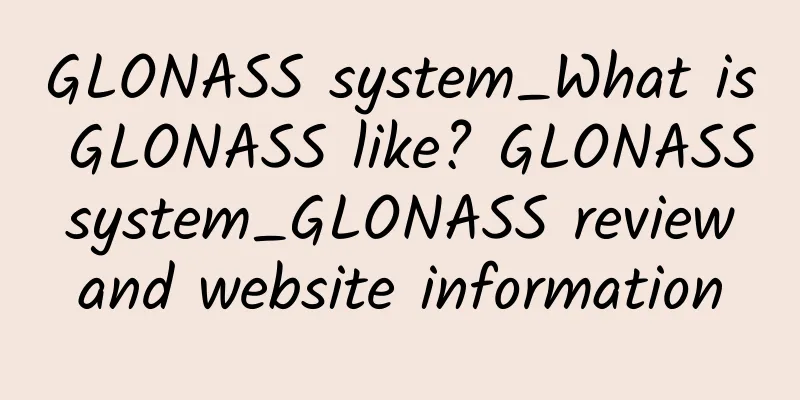GLONASS system_What is GLONASS like? GLONASS system_GLONASS review and website information

|
GLONASS_What is GLONASS? GLONASS (Global Navigation Satellite System) is a satellite navigation system developed by the former Soviet Union and is now operated by the Russian government. Website: www.glonass-iac.ru GLONASS: The pioneer of global navigation satellite systemsIn the wave of modern science and technology, satellite navigation technology has become an indispensable part. Whether it is providing precise positioning services for individuals or supporting key infrastructure at the national and corporate levels, the Global Navigation Satellite System (GNSS) plays a vital role. Among them, the GLONASS system (Global Navigation Satellite System), as a global navigation satellite network developed and operated by Russia, is not only one of the four major GNSS in the world, but also an important milestone in the development of navigation and positioning technology worldwide. This article will explore in depth the historical background, technical features, application areas of the GLONASS system, and the information resources provided by its official website www.glonass-iac.ru to help readers fully understand this powerful navigation system and its influence around the world. The origin and development of the GLONASS systemThe development of the GLONASS system dates back to the Cold War. The former Soviet Union began planning this project in the 1970s to provide precise navigation and positioning services for its military and civilian needs. The original design goal was to create a navigation system that could cover the globe to ensure that the Soviet army could obtain reliable coordinate information at any location and time. In 1982, the first GLONASS satellite was successfully launched, marking the official launch of the system. However, due to technical limitations and economic problems at the time, the early GLONASS system did not fully achieve its intended functions. After the collapse of the Soviet Union, the Russian government continued to invest a lot of resources in upgrading and expanding GLONASS, making it a mature and efficient global navigation system. Since the beginning of the 21st century, GLONASS has undergone several major improvements. In 2007, Russia announced that it would provide free GLONASS signal services to users around the world, a step that greatly promoted its internationalization process. In the following years, by continuously optimizing the constellation configuration and technical performance, GLONASS gradually narrowed the gap with the US GPS system and formed unique competitive advantages in many areas. Technical architecture of the GLONASS systemAs a complete global navigation satellite system, GLONASS consists of three parts: space segment, ground segment and supporting user segment:
It is worth noting that GLONASS uses a unique frequency allocation scheme. Unlike GPS, each GLONASS satellite transmits signals at a different frequency. Although this method increases complexity, it also brings higher anti-interference ability and more accurate time synchronization capability. Application areas of the GLONASS systemWith its excellent technical characteristics and wide coverage, GLONASS has demonstrated great practical value in many fields:
GLONASS system official website: www.glonass-iac.ruFor those who want to learn more about the GLONASS system, its official website www.glonass-iac.ru is an indispensable source of information. The website is maintained by the International Association of GLONASS Users and Developers (IAC GLONASS) of Russia and contains rich and detailed information covering all aspects related to GLONASS. Visitors can find the following key categories of information on the website:
In addition, www.glonass-iac.ru also has a dedicated education section to introduce the basics of GNSS and the unique features of GLONASS to the general public and students. This open and sharing attitude not only enhances transparency, but also helps promote the healthy development of the entire industry. Future Prospects of GLONASS SystemAs the global demand for precision navigation continues to grow, the GLONASS system is also evolving. Currently, Russia is implementing a GLONASS modernization plan, focusing on the following aspects:
Looking ahead, GLONASS is expected to maintain its own characteristics while building a more complete and unified navigation ecosystem with other GNSS around the world. Whether in daily life or professional fields, we can expect GLONASS to bring more surprises and convenience. ConclusionAs one of the four major GNSS in the world, GLONASS has become an indispensable part of modern navigation with its profound technical accumulation and broad application prospects. From its initial military use to today's comprehensive service system covering transportation, agriculture, geology and other fields, the development history of GLONASS fully demonstrates how scientific and technological progress has changed our lives. If you want to learn more about GLONASS, please feel free to visit its official website www.glonass-iac.ru . Here, you can not only obtain authoritative technical information, but also feel the charm and potential of this legendary navigation system. |
<<: Astrakhan State Technical University
>>: How is JR Hokkaido Railway Company? JR Hokkaido Railway Company reviews and website information
Recommend
The efficacy and function of pomegranate
Sour pomegranate is also a kind of pomegranate, b...
The efficacy and function of cowpea, the purchase and storage of cowpea
Here is some basic knowledge about cowpea, as wel...
What is the Brazilian Stock Exchange like? Brazilian Stock Exchange Reviews and Website Information
What is the website of the Brazilian Stock Exchang...
The nutritional value and efficacy of sea hares and the taboos of eating sea hares
The sea hare is a magical marine creature and a c...
Nutritional value of jackfruit seeds
Jackfruit seeds are the cores of the fruit that w...
How to grow bear's paw flower and how to plant bear's paw flower
Bear's Paw Flower is a succulent plant that m...
The nutritional value and efficacy of orange
Leaf orange, also known as small leaf orange, is ...
What is The Fiji Times like? Reviews and website information
What is the Fiji Times website? The Fiji Times is ...
How is the price? Price review and website information
What is Price? Price is a Russian digital and home...
What is Freeport-McMoRan Copper & Gold? Freeport-McMoRan Copper & Gold Reviews and Website Information
What is the website of Freeport-McMoRan? Freeport-...
What is Akzo Nobel like? Akzo Nobel reviews and website information
What is Akzo Nobel? Akzo Nobel is a Dutch chemical...
Blueberry Wine
Everyone knows that blueberries are delicious, bu...
What is Cisco like? Cisco reviews and website information
What is Cisco? Cisco Systems is a leading global n...
Kidney-nourishing black rice porridge
Introduction to Kidney-Nourishing Black Rice Porr...
How to make red scallion How to make red scallion delicious
Red amaranth is a wild vegetable. It contains a l...









